Deck 4: Revolutionary America: Change and Transformation, 1764-1783
Question
Question
Question
Question
Question
Question
Question
Question
Question
Question
Question
Question
Question
Question
Question
Question
Question
Question
Question
Question
Question
Question
Question
Question
Question
Question
Question
Question
Question
Question
Question
Question
Question
Question
Question
Question
Question
Question
Question
Question
Question
Question
Question
Question
Question
Question
Question
Question
Question
Question

Unlock Deck
Sign up to unlock the cards in this deck!
Unlock Deck
Unlock Deck
1/50
Play
Full screen (f)
Deck 4: Revolutionary America: Change and Transformation, 1764-1783
1

Prime Minister George Grenville and Parliament passed the Sugar Act in order to
A) tax sugar and other goods imported to the colonies
B) raise duties on molasses
C) reduce penalties for smuggling
D) subject violators of this act to trials by jury
tax sugar and other goods imported to the colonies
2
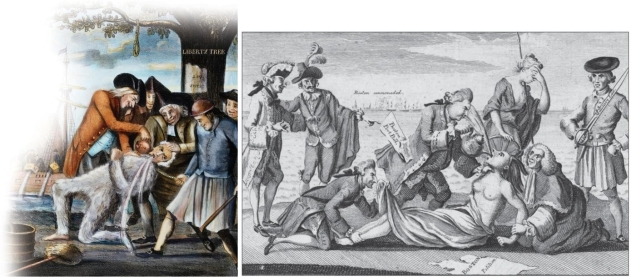
How are the pro-British cartoon showing a tarred-and-feathered customs official and Paul Revere's engraving The Able Doctor, or America Swallowing the Bitter Draught similar?
A) They both show each side's perception of the Boston Tea Party.
B) Each features allegorical figures that represent the colonies and Britain.
C) Each shows its subject as the victim of cruel violence.
D) They both portray Americans as crude and thuggish.
Each shows its subject as the victim of cruel violence.
3
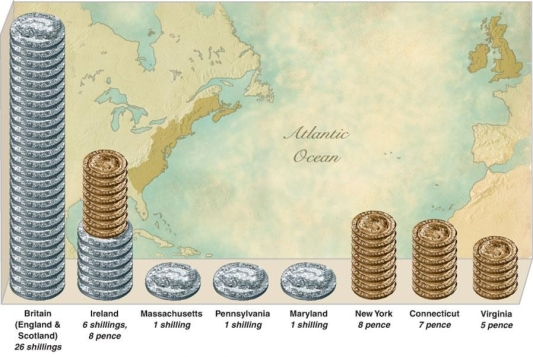
What conclusion can be reached by interpreting this graph that compares annual per capita tax rates between Britain and its American colonies in 1765?
A) Americans paid more than their fair share of taxes to support the British Empire.
B) Americans opposed taxation because they were not represented in Parliament.
C) British citizens paid less tax money than the colonists in America and Ireland.
D) Americans were generally wealthier than comparable workers in Britain.
Americans were generally wealthier than comparable workers in Britain.
4
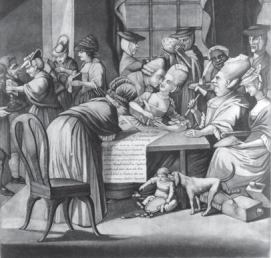
This British cartoon portrays American women from Edenton, North Carolina, who participated in the colonial boycott of tea as .
A) weak and ineffective
B) powerful politicians
C) aspiring to usurp male authority
D) insubordinate and lacking virtue

Unlock Deck
Unlock for access to all 50 flashcards in this deck.
Unlock Deck
k this deck
5
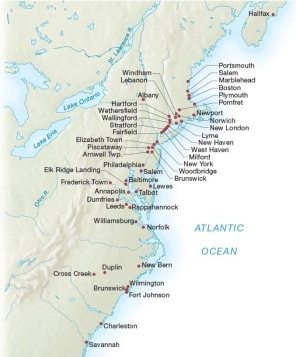
This map of the American colonies shows that protests to the Stamp Act were most frequent in
A) the Indian reserve
B) the lower South
C) seaports
D) the backcountry

Unlock Deck
Unlock for access to all 50 flashcards in this deck.
Unlock Deck
k this deck
6
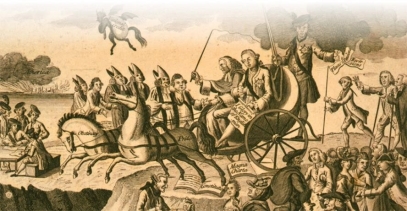
Which of the following best describes the position of the Loyalists?
A) They wished to maintain allegiance with the British crown.
B) They were on the side of neither the Patriots nor the British forces.
C) They believed that democracy was the best form of government.
D) They wanted to return to Great Britain.

Unlock Deck
Unlock for access to all 50 flashcards in this deck.
Unlock Deck
k this deck
7
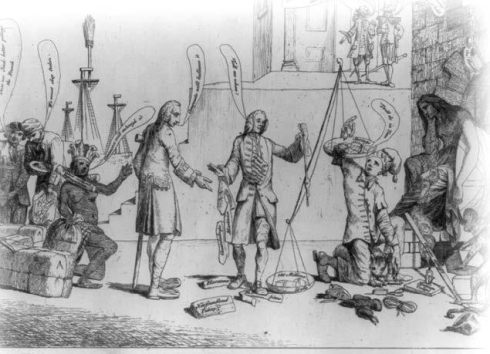
The scale in the cartoon The Great Financier is out of balance because .
A) people in Britain were paying heavier taxes than Americans to manage their country's debt
B) Britain's debts far outweighed its profits in administering the American colonies
C) most of the taxes imposed by Britain were on the shipping industry
D) Native Americans were required to pay more taxes than white colonists

Unlock Deck
Unlock for access to all 50 flashcards in this deck.
Unlock Deck
k this deck
8

How did the end of the French and Indian War lead to deteriorating relationships between Britain and its American colonies?
A) Britain outlawed slavery in the territories won from France.
B) Americans called for a change to a representative government instead of remaining a monarchy.
C) Americans demanded greater property rights for colonial women.
D) The British raised taxes without colonial consent in order to pay off the war debt.

Unlock Deck
Unlock for access to all 50 flashcards in this deck.
Unlock Deck
k this deck
9

Colonial women who boycotted imported British goods such as fabrics and tea did so as part of nonimportation agreements in response to the .
A) Sugar Act
B) Intolerable Acts
C) Townshend Acts
D) Tea Act

Unlock Deck
Unlock for access to all 50 flashcards in this deck.
Unlock Deck
k this deck
10

What percentage of the white population in the American colonies were Loyalists?
A) 50 percent
B) 40 percent
C) 30 percent
D) 20 percent

Unlock Deck
Unlock for access to all 50 flashcards in this deck.
Unlock Deck
k this deck
11

Lord Dunmore's Proclamation promised to .
A) outlaw colonial militias
B) free any slave who joined the British forces
C) give free land to any colonist who settled west of the Appalachians
D) lower taxes in Virginia

Unlock Deck
Unlock for access to all 50 flashcards in this deck.
Unlock Deck
k this deck
12

The boiling teapot shown in The Tea-Tax-Tempest suggests that .
A) France was unwilling to support the American colonies in their struggle against Britain
B) Americans were ready to reconcile with Britain
C) Americans felt it was still possible to remain within the British Empire and protect their rights
D) American and British soldiers were ready to go to war against each other

Unlock Deck
Unlock for access to all 50 flashcards in this deck.
Unlock Deck
k this deck
13

Under the Prohibitory Act, Parliament outlawed .
A) trade with the thirteen colonies
B) printing and distribution of publications supporting independence
C) colonial militias
D) possession of property by Loyalists

Unlock Deck
Unlock for access to all 50 flashcards in this deck.
Unlock Deck
k this deck
14

Parliament affirmed that it had the power to pass binding laws on the colonies under the
A) Declaratory Act
B) Sugar Act
C) Intolerable Acts
D) Townshend Acts

Unlock Deck
Unlock for access to all 50 flashcards in this deck.
Unlock Deck
k this deck
15

How did the Whig theory of virtual representation contribute to the tensions leading to the American Revolution?
A) The colonists felt that they were entitled to trial by a jury of their peers.
B) The British placed more faith than the colonists did in the power of the crown.
C) The British did not comprehend the colonists' view that they had no voice in Parliament.
D) The colonists believed that Parliament could represent their interests but the king could not.

Unlock Deck
Unlock for access to all 50 flashcards in this deck.
Unlock Deck
k this deck
16

The First Continental Congress approved the Resolves of Suffolk County, Massachusetts, which denounced the Intolerable Acts because these laws were _.
A) unenforceable
B) a violation of rights and liberties
C) poorly written
D) an attempt by the monarchy to impose additional taxes

Unlock Deck
Unlock for access to all 50 flashcards in this deck.
Unlock Deck
k this deck
17

The British passed the Intolerable Acts as a direct reaction to .
A) American boycotts of tea and other imported goods
B) colonial participation in the Boston Tea Party
C) the mob violence associated with the tar-and-feathering of tax collectors
D) punish colonists for settling west of the Appalachians

Unlock Deck
Unlock for access to all 50 flashcards in this deck.
Unlock Deck
k this deck
18

The "Declaration of the Rights and Grievances of the Colonies" drafted by the nine colonies represented at the Stamp Act Congress demonstrated that .
A) most of the colonies were ready to declare independence from Britain
B) the different colonies had to work together for a common goal
C) colonists no longer advocated for a monarchical form of government
D) most Americans favored the policies of the Stamp Act

Unlock Deck
Unlock for access to all 50 flashcards in this deck.
Unlock Deck
k this deck
19

George Mason stated that "…the natural strength and only stable security of a free Government" came from .
A) well-regulated militias
B) alliances with foreign powers
C) dependence on using slaves to fight enemies
D) colonial assemblies

Unlock Deck
Unlock for access to all 50 flashcards in this deck.
Unlock Deck
k this deck
20

What impression of the conflict between Britain and the American colonies is represented in the British cartoon The Political Cartoon for the Year 1775?
A) the idea that Americans should remain loyal to King George III
B) the strong regard that King George III had for the Magna Carta and the British Constitution
C) resignation about the inevitability of war between Britain and the American colonies
D) the fact that the colonists could no longer expect the British political and legal systems to protect their liberty

Unlock Deck
Unlock for access to all 50 flashcards in this deck.
Unlock Deck
k this deck
21
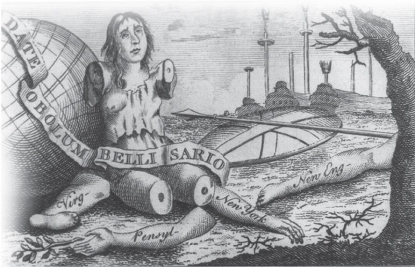
Why was the Declaration of Independence aimed at a foreign as well as a domestic audience?
A) to encourage other nations to turn to democracy
B) to defend the new nation from attack
C) to gain support from other nations against the British
D) to denounce monarchies worldwide

Unlock Deck
Unlock for access to all 50 flashcards in this deck.
Unlock Deck
k this deck
22
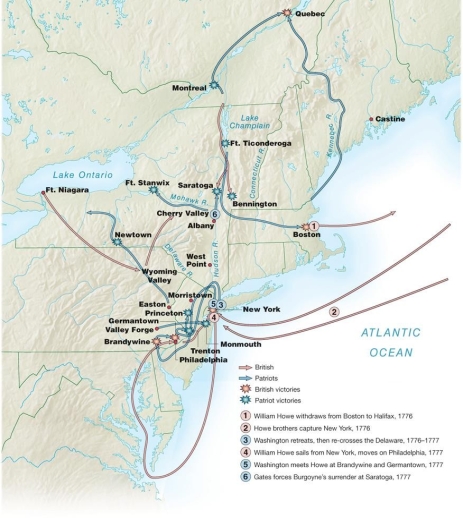
Why did the British retreat to New York after defeating the Patriots in Boston?
A) They wanted to isolate Patriot New England from the rest of the colonies.
B) There were too many Loyalists in New England.
C) The terrain in New England was far more treacherous for fighting than that in New York.
D) They hoped to destroy Patriot morale by occupying New York City.

Unlock Deck
Unlock for access to all 50 flashcards in this deck.
Unlock Deck
k this deck
23

The person responsible for drafting the formal resolution that became the Declaration of Independence was .
A) Richard Henry Lee
B) Benjamin Franklin
C) John Adams
D) Thomas Jefferson

Unlock Deck
Unlock for access to all 50 flashcards in this deck.
Unlock Deck
k this deck
24

During the American Revolution, Loyalists used this 1760s engraving designed by Benjamin Franklin to display their personal fear that .
A) women married to Loyalists would lose their property and face harsh consequences
B) the colonies would not be able to function separately from Britain
C) the division between Patriots and Loyalists would result in the collapse of the colonial economy
D) war would destroy the British Empire

Unlock Deck
Unlock for access to all 50 flashcards in this deck.
Unlock Deck
k this deck
25
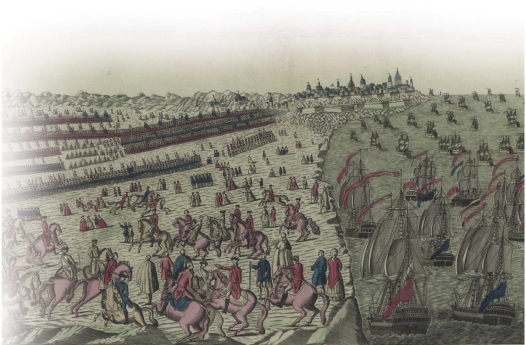
How does this French image of the victory at Yorktown portray the French forces?
A) Their army and navy are shown as the reason for defeating the British.
B) They are depicted as surrendering in humiliation to the British.
C) They are responsible for constructing the fortified walls that protect Yorktown.
D) They recognize that the American forces were equal partners in this battle.

Unlock Deck
Unlock for access to all 50 flashcards in this deck.
Unlock Deck
k this deck
26

The unconventional style of guerrilla warfare used in the South during the American Revolution was most closely associated with .
A) Lord Cornwallis
B) Horatio Gates
C) Francis Marion
D) George Washington

Unlock Deck
Unlock for access to all 50 flashcards in this deck.
Unlock Deck
k this deck
27

How did the British respond to the strong Patriot resistance encountered at Bunker Hill and the creation of the Continental Army under General George Washington?
A) They offered incentives to Loyalists to join their side.
B) They prepared for a sustained military conflict.
C) They explored options for withdrawal from the conflict.
D) They sought more assistance from European powers.

Unlock Deck
Unlock for access to all 50 flashcards in this deck.
Unlock Deck
k this deck
28

At the beginning of the America Revolution, which of the following was an advantage in favor of Patriot forces?
A) a colonial population greater than that of Britain
B) the support of militia forces
C) French military and naval support
D) a population overwhelmingly in support of independence from Britain

Unlock Deck
Unlock for access to all 50 flashcards in this deck.
Unlock Deck
k this deck
29

Why was there a possibility that the property belonging to Grace Growden Galloway of Philadelphia would be confiscated during the Revolution?
A) She was married to a Loyalist.
B) She permitted British troops to use her home.
C) She had decided to take up the cause of the Patriots against her husband's wishes.
D) She had abandoned her property and fled with her husband.

Unlock Deck
Unlock for access to all 50 flashcards in this deck.
Unlock Deck
k this deck
30

As illustrated on this map, what was one major difference in the troop movements of the Patriot and British forces?
A) Patriots troops remained within the boundaries of the thirteen colonies.
B) British troops generally moved north from the Southern colonies to engage the Patriots.
C) British troops heavily relied on their navy to transport them to and within the colonies.
D) British troops stayed near the coast, whereas Patriot troops remained inland.

Unlock Deck
Unlock for access to all 50 flashcards in this deck.
Unlock Deck
k this deck
31

How did Thomas Paine's pamphlet Common Sense change Americans' views on politics?
A) It denounced monarchy as being ridiculous and incompatible with liberty.
B) It viewed democracy as a danger to be avoided.
C) It explained that independence could be achieved without war.
D) It argued that constitutional monarchy is the best system of government.

Unlock Deck
Unlock for access to all 50 flashcards in this deck.
Unlock Deck
k this deck
32
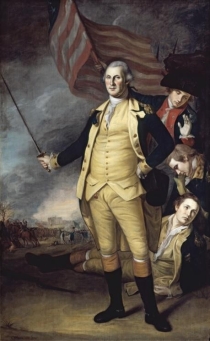
Charles Wilson Peale's portrait of George Washington at the Battle of Princeton shows that he became a symbol of the virtuous new American republic as a result of the .
A) success in defeating the British army
B) sacrifices made by his soldiers
C) military support given by France and other European powers
D) heroic efforts of African Americans under his command

Unlock Deck
Unlock for access to all 50 flashcards in this deck.
Unlock Deck
k this deck
33

In 1779-1780, the British turned their attention to the South because of their greater
A) opportunity to use their navy to capture ports and cities in this region
B) reliance on slaves to tip the balance of power in their favor
C) possibility of fighting the Continental Army in a conventional style
D) prospect of gaining support from the large Loyalist population

Unlock Deck
Unlock for access to all 50 flashcards in this deck.
Unlock Deck
k this deck
34

The Battle of was a turning point in the American Revolution that convinced France to commit forces to aid the colonists.
A) Bunker Hill
B) Brooklyn Heights
C) Saratoga
D) Princeton

Unlock Deck
Unlock for access to all 50 flashcards in this deck.
Unlock Deck
k this deck
35
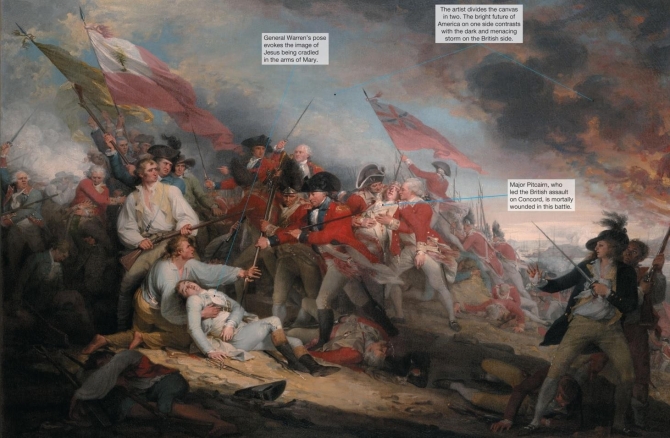
How did John Trumbull's The Death of General Warren at the Battle of Bunker Hill enhance the moral complexity of the events taking place at this first major battle of the American Revolution?
A) African Americans like Peter Salem, who supposedly killed Major Pitcairn, are prominently featured as the heroes of this battle.
B) Trumbull focuses more on the chaos of the battle rather than the heroic actions of the soldiers involved from each side.
C) General Warren's sacrifice of life and British Major John Small's intervention to prevent one of his own men from bayonetting Warren show that both sides displayed virtue and heroism.
D) The refusal of American soldiers to follow military orders from their own officers illustrates the spirit of independence and insubordination.

Unlock Deck
Unlock for access to all 50 flashcards in this deck.
Unlock Deck
k this deck
36

The Battle of Lexington took place when British troops marched from Boston in order to
A) capture Paul Revere
B) seize military supplies from nearby Concord
C) invade the mid-Atlantic colonies
D) punish civilians who had not paid their taxes

Unlock Deck
Unlock for access to all 50 flashcards in this deck.
Unlock Deck
k this deck
37

What did the court decision in the 1805 case of Martin v. Commonwealth, which returned a Loyalist woman's confiscated property to her heir, reveal about women's roles in the decades immediately after the American Revolution?
A) The ideals of individual autonomy and liberty emphasized during the Revolution gave them the right to decide whether to flee or to stay on Patriot-controlled lands during that conflict.
B) They had gained the power to execute their final wills and testaments and could choose to pass on property to whomever they wanted.
C) The doctrine of coverture took away their legal rights and personal identity when they married so that they had to abide by their husbands' decisions.
D) Women who owned property at the time of the Revolution received the right to vote in state elections.

Unlock Deck
Unlock for access to all 50 flashcards in this deck.
Unlock Deck
k this deck
38

How did King George III's rejection of the "Olive Branch" petition sent by the First Continental Congress impact British relations with the colonies after July 1775?
A) The Continental Congress declared war on the British government.
B) British troops were given the authority to arrest Patriots and seize their property.
C) Great numbers of Loyalists decided to become Patriots instead.
D) Those who supported independence believed that reconciliation was no longer possible.

Unlock Deck
Unlock for access to all 50 flashcards in this deck.
Unlock Deck
k this deck
39

Britain declared war on Holland during the American Revolution because .
A) Holland had sent troops to fight on behalf of the Patriots
B) Holland was a significant source of supplies to the Patriots
C) Holland tried to take away control of Canada from Britain
D) Holland was trying to persuade other nations to join the struggle against the British

Unlock Deck
Unlock for access to all 50 flashcards in this deck.
Unlock Deck
k this deck
40
![<strong> In his September 24, 1776, letter to the President of Congress, George Washington referred to the disorderliness and independence of by describing them as men accustomed to unbounded freedom, and no control, [who] cannot brook the Restraint which is indispensably necessary to the good order and Government of an Army.</strong> A) British soldiers B) soldiers in the standing Continental Army C) African American soldiers D) colonial militias](https://d2lvgg3v3hfg70.cloudfront.net/TB7452/11eb190b_3bd2_3b42_88d6_3bf20c0f0470_TB7452_00.jpg)
In his September 24, 1776, letter to the President of Congress, George Washington referred to the disorderliness and independence of by describing them as "men accustomed to unbounded freedom, and no control, [who] cannot brook the Restraint which is indispensably necessary to the good order and Government of an Army."
A) British soldiers
B) soldiers in the standing Continental Army
C) African American soldiers
D) colonial militias

Unlock Deck
Unlock for access to all 50 flashcards in this deck.
Unlock Deck
k this deck
41
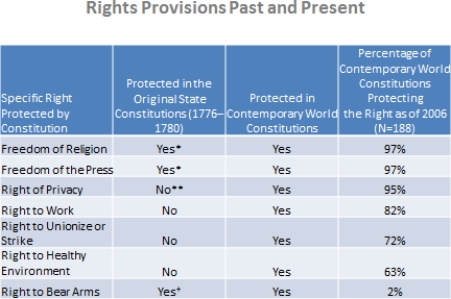
What conclusion can be made about modern constitutions when comparing them to the state constitutions written in the United States in the years after the American Revolution?
A) A large number of modern constitutions make the right to own firearms a priority.
B) Modern constitutions place little emphasis on environmental issues.
C) Most of the rights protected by modern constitutions deal with social and economic issues.
D) The right of privacy was a major concern for Americans living in the eighteenth century.

Unlock Deck
Unlock for access to all 50 flashcards in this deck.
Unlock Deck
k this deck
42
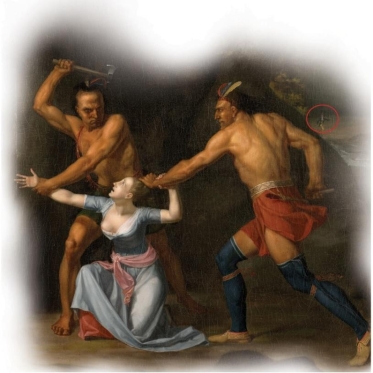
How did John Vanderlyn's painting depicting the death of Loyalist Jane McCrea by Mohawk Indians influence and shape colonial attitudes during the American Revolution?
A) American perceptions about Indians being barbaric savages were intensified.
B) American Patriots deepened their resentment toward Loyalists in the colonies.
C) Americans realized that the sacrifices made by colonial women entitled them to participate in political affairs.
D) Americans recognized the heroic efforts of Indians who sided against the British and their Loyalist supporters.

Unlock Deck
Unlock for access to all 50 flashcards in this deck.
Unlock Deck
k this deck
43

Why did many Indian nations ally with the British during the American Revolution?
A) They believed that they could defeat the British following a victory over the Americans.
B) The British had promised to cede territory within the thirteen colonies to them.
C) The British regarded them as equals, whereas the colonists did not.
D) They feared that a Patriot victory would mean westward expansion into their territory.

Unlock Deck
Unlock for access to all 50 flashcards in this deck.
Unlock Deck
k this deck
44
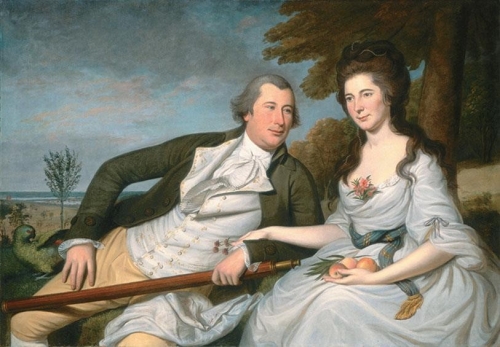
Charles Wilson Peale's portrait of Benjamin and Eleanor Ridgely Laming breaks with the tradition of painting separate portraits of husbands and wives to reflect the concept of
A) companionate marriage
B) political equality between men and women
C) patriarchal authority
D) the supremacy of fatherhood

Unlock Deck
Unlock for access to all 50 flashcards in this deck.
Unlock Deck
k this deck
45

What view might have contributed most to Americans' continuation of slavery while also supporting liberty for themselves?
A) the belief that only property owners have a stake in government
B) distrust of powerful central governments
C) the notion that government rests on the consent of the governed
D) an understanding that abolition would ultimately be inevitable

Unlock Deck
Unlock for access to all 50 flashcards in this deck.
Unlock Deck
k this deck
46

Which of the following factors motivated the Regulators to take the ideals of equality and liberty in their attempt to reform society in the Carolinas?
A) resentment of backcountry farmers
B) a belief in abolition
C) a desire to eliminate government corruption
D) support for a larger tax base to finance local government

Unlock Deck
Unlock for access to all 50 flashcards in this deck.
Unlock Deck
k this deck
47

The Pennsylvania Constitution was considered more radical than other state constitutions because it .
A) extended suffrage to women
B) immediately abolished all slavery
C) banned the use of militias
D) did away with property requirements for voting

Unlock Deck
Unlock for access to all 50 flashcards in this deck.
Unlock Deck
k this deck
48

What made New Jersey unique with regard to suffrage?
A) Suffrage was limited to those who fought for the Patriot cause.
B) Suffrage was extended to those without property.
C) Suffrage was granted to former slaves.
D) Suffrage was initially extended to both men and women.

Unlock Deck
Unlock for access to all 50 flashcards in this deck.
Unlock Deck
k this deck
49

The American Revolution officially came to an end when .
A) Cornwallis surrendered to Washington after the Battle of Yorktown
B) British and American diplomats signed the Treaty of Paris in 1783
C) France joined forces with the Americans after the Battle of Saratoga
D) Britain declared war on Holland

Unlock Deck
Unlock for access to all 50 flashcards in this deck.
Unlock Deck
k this deck
50

John Adams's dismissive reply to his wife Abigail's appeal to "Remember the Ladies" contradicted his ideal of during the American Revolution.
A) abolishing slavery
B) reforming property laws
C) reorganizing the legal system
D) extending democracy

Unlock Deck
Unlock for access to all 50 flashcards in this deck.
Unlock Deck
k this deck



